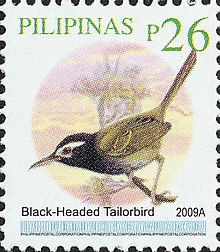Black-headed tailorbird
First formally described by the Scottish ornithologist Arthur Hay in 1877, it is endemic to the southeastern Philippines, where it is found on the islands of Mindanao, Dinagat, and Siargao.
Adults have dull black heads, necks, throats, and chests with a prominent white supercilium, line beneath the eye, and chin patch.
Immature birds have the chin, throat, and upper breast whitish with light grey and black mottling, as well as shorter tails.
The black-headed tailorbird was formally described in 1877 as Orthotomus nigriceps by the Scottish ornithologist Arthur Hay on the basis of a juvenile male specimen from Butuan on the island of Mindanao in the Philippines.
[3][4] In 1943, the Japanese ornithologist Masauji Hachisuka described O. nigrogularis as a new species based on an adult male specimen collected from the eastern Gulf of Davao, Mindanao.
[5] O. nigrogularis was made a junior synonym of O. nigriceps in 1950 by the American ornithologist Sidney Dillon Ripley; Ripley referred to a 1947 paper by the German-American biologist Ernst Mayr, in which Mayr hypothesized that differences in throat color within the black-headed tailorbird could be attributed to sexual dimorphism.
In 2022, the American ornithologist Matthew Halley studied a larger number of skins, showing the species was sexually monomorphic.
[2] The black blends into dull grey on the lower breast and belly, the latter having faint whitish tips to the feathers.
The iris is chestnut-brown, the legs are pale pink, and upper and lower mandibles of the bill are blackish and whitish, respectively.
[9] Immature birds have the chin, throat, and upper breast whitish with light grey and black mottling, as well as a shorter tail with an average length of 38.5–41 mm (1.52–1.61 in).
Other calls include an anxious, falling ssiirrrrpppppp and a ringing key-e ei, the second of which is similar to the long-tailed bush warbler's song.
[9] The black-headed tailorbird is endemic to the southeastern Philippines, where it is found on the islands of Mindanao, Dinagat, and Siargao.
[9] A 2021 study of avian biodiversity near Mount Pantaron in Bukidnon found that the black-headed tailorbird, like other Philippine endemics, was absent from agricultural ecosystems but present in nearby montane forests.
